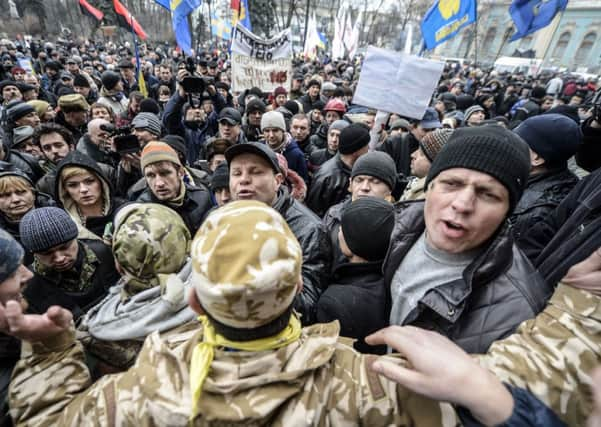Ukraine: Russia scrambles jets to patrol border


Gunmen meanwhile stormed building’s in Ukraine’s southern Crimea region and raised the Russian flag over its parliament.
The moves pose an immediate challenge to Ukraine’s new authorities as they seek to set up an interim government in a country whose population is divided in loyalties between Russia and the West.
Advertisement
Hide AdAdvertisement
Hide AdUkraine’s new prime minister said its future lies in the European Union but with friendly relations with Russia. Moscow, meanwhile, has launched a major military exercise involving 150,000 troops and sent fighter jets to patrol its border.
Russian news media reported that ousted president Yanukovich, who was driven out of Kiev by a three-month protest movement, was staying in a Kremlin retreat just outside Moscow after first staying at a hotel.
“I have to ask Russia to ensure my personal safety from extremists,” he said in a statement. He said he still considered himself president and does not recognise the new regime in Kiev. Russian officials, including president Vladimir Putin’s spokesman, said they had no information about Mr Yanukovich’s arrival in Moscow.
Mr Yanukovich’s decision to ditch closer ties to the EU and turn to Moscow instead sparked weeks of protests in Kiev. He fled after riot police attacked protesters in Kiev’s central square, killing more than 80 people. He has not been seen publicly since Saturday.
In Kiev, MPs chose Arseniy Yatsenyuk as the new premier. He will face the task of restoring stability in a country on the verge of financial collapse.
The 39-year-old served as economy minister, foreign minister and parliamentary speaker before Mr Yanukovich took office in 2010, and is widely viewed as a technocrat viewed favourable by the United States.
Shortly before MPs chose him as the leader of the new Cabinet, Mr Yatsenyuk said Ukraine does not want a fight with Russia, but would not accept the secession of Crimea. He said Crimea “has been and will be a part of Ukraine”.
The Black Sea peninsula, where most residents are ethnic Russians and where Russia maintains a naval base for its Black Sea fleet, has become the latest flashpoint in Ukraine’s crisis. Yesterday in regional capital, Simferopol, witnesses said gunmen wearing unmarked camouflage uniforms and carrying rocket-propelled grenades, sniper rifles and other weapons seized local government buildings and raised the Russian flag over the regional parliament.
Advertisement
Hide AdAdvertisement
Hide AdThey did not voice any demands and threw a flash grenade in response to a journalist’s questions. They wore black and orange ribbons, a Russian symbol of the victory in the Second World War, and put up a sign reading “Crimea is Russia”.
Later in the day, hundreds of pro-Russian protesters gathered outside the parliament, waving Russian flags and signs calling for Crimea to join Russia. Protest organiser Oleg Slusarenko announced that deputies had voted to hold a referendum on expanding Crimea’s autonomy on 25 May.
Russian news agencies reported that the Crimean legislature had held an emergency session – despite the occupation of the building – and removed the local governor, replacing him with Sergei Aksyonov, the head of Russian Unity, the main pro-Russian party on the peninsula.
In Brussels, US defence secretary Chuck Hagel urged Russia not to take any action on Ukraine that might boost tensions.
After a Nato defence meeting, he said: “These are times for cool, wise leadership on Russia’s side and everyone’s side.”